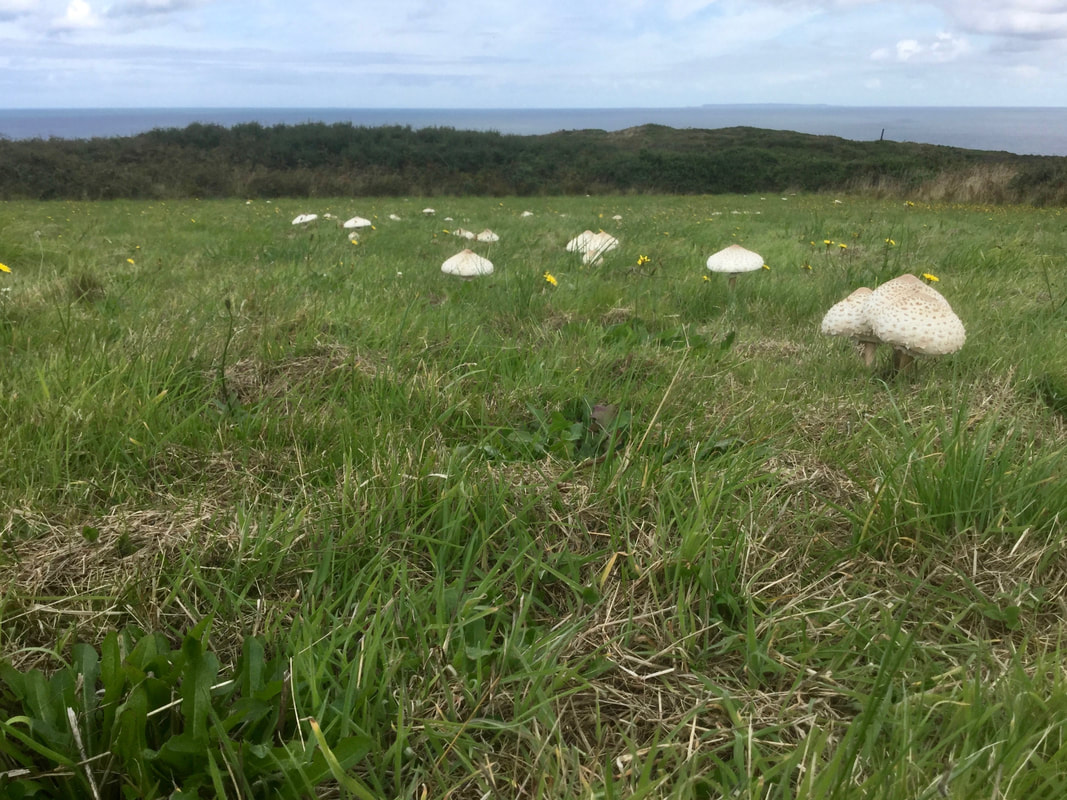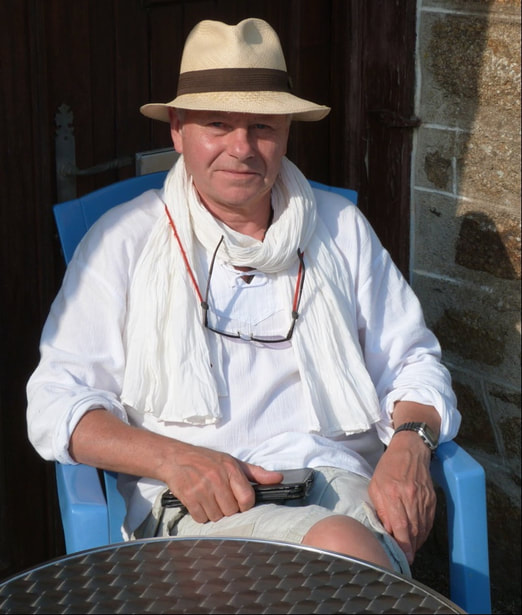L’Eperquerie is the name given to the delightful moorland on the north coast of the beautiful Island of Sark. Standing proudly facing west out to sea and overseeing the sister islands of Guernsey and Herm is a wonderful Buddhist sculpture. But what exactly is it doing there?
This answer to this question is simple. It is a work carved into a rock by a visiting Tibetan monk and his friend. It was an artistic creation that they produced for the advent of the 21st. century. They were invited to come to Sark by someone who loves the island, but the identity of whom remains a mystery. The romantic in one, imagines them being summoned by conch shell blown by this devotee in Sark, the sound travelling over sea and land until its message saying come hither, was heard by the monk high up the slopes in his Tibetan monastery. He immediately packed a few possessions and left his mountain retreat with his friend beside him. You can imagine them walking across Asia and Europe, resplendent in their flowing orange robes, begging for alms as they travelled diligently for many months until they reached the western coast of France. An old caravel captained by a French sailor in a tricolor hat, transported them to the final destination of Sark. The realist in one however concludes that they received a letter, email or telephone call inviting them to pay a visit. They simply got on several aeroplanes, flew into Guernsey and took the inter island ferry to Maseline harbour, walked up the hill and found themselves in Sark Avenue.
Sark is an enchanting place, being there is like stepping back in time, the pace of life is slow and the air is clean and fresh. The automobile is nowhere to be found, as the people who live there, travel about by bicycle and horse and cart. The only motor vehicles allowed are tractors to work the fields. The scenery is incredibly natural and enchanting. There are tiny coves, winding woodland paths and the stark moorland such as L’Eperquerie. When the monk reached this spot, he selected a suitably large stone and lovingly engraved the Buddhist mantra “Om Mani Padme Hum” on its surface.
This answer to this question is simple. It is a work carved into a rock by a visiting Tibetan monk and his friend. It was an artistic creation that they produced for the advent of the 21st. century. They were invited to come to Sark by someone who loves the island, but the identity of whom remains a mystery. The romantic in one, imagines them being summoned by conch shell blown by this devotee in Sark, the sound travelling over sea and land until its message saying come hither, was heard by the monk high up the slopes in his Tibetan monastery. He immediately packed a few possessions and left his mountain retreat with his friend beside him. You can imagine them walking across Asia and Europe, resplendent in their flowing orange robes, begging for alms as they travelled diligently for many months until they reached the western coast of France. An old caravel captained by a French sailor in a tricolor hat, transported them to the final destination of Sark. The realist in one however concludes that they received a letter, email or telephone call inviting them to pay a visit. They simply got on several aeroplanes, flew into Guernsey and took the inter island ferry to Maseline harbour, walked up the hill and found themselves in Sark Avenue.
Sark is an enchanting place, being there is like stepping back in time, the pace of life is slow and the air is clean and fresh. The automobile is nowhere to be found, as the people who live there, travel about by bicycle and horse and cart. The only motor vehicles allowed are tractors to work the fields. The scenery is incredibly natural and enchanting. There are tiny coves, winding woodland paths and the stark moorland such as L’Eperquerie. When the monk reached this spot, he selected a suitably large stone and lovingly engraved the Buddhist mantra “Om Mani Padme Hum” on its surface.
Om is the infinite soul within us. Mani is the jewel. Padme is the expression of this jewel in the in the form of a lotus flower that is the symbol of enlightenment. The lotus grows in muddy water and this flower represents rising and blooming above the murk of human suffering to achieve enlightenment. A white lotus flower signifies the purity of mind and spirit. A red lotus flower represents love and compassion. A blue lotus flower signifies the importance of common sense. A pink lotus reminds us of the historical path taken by the Buddha. If the lotus flower is purple it guides us to the principles of spirituality and mysticism. Finally a gold lotus represents enlightenment itself. Hum is the spirit of enlightenment. Om at the beginning of the mantra is the infinite soul within us, but Hum at the end of this mantra reveals both the emptiness of all things as well as all things within the emptiness.
So we see that within this simple mantra, there is contained all the wisdom of the Buddha, every last drop of it! This monk and his friend bought the wealth of this spiritual knowledge to the beautiful island of Sark and we have much to thank him for. Perhaps you are tempted to visit this exquisite island jewel as well?
I think that it would be most suitable to end this with the words of the Dalai Lama:
“Thus the six syllables, Om Mani Padme Hum, means that in dependence on the practice of a path that is an indivisible union of method and wisdom, you can transform your impure body, speech, and mind into the pure exalted body, speech, and mind of a Buddha. It is said that you should not seek for Buddhahood outside of yourself; the substances for the achievement of Buddhahood are within. As Maitreya says in his Sublime Continuum of the Great Vehicle (uttaratantra, rgyud bla ma), all beings naturally have the Buddha-nature in their own continuum. We have within us the seed of purity, the matrix-of-One-Gone-Thus, that is to be transformed and fully developed into Buddhahood”.
So we see that within this simple mantra, there is contained all the wisdom of the Buddha, every last drop of it! This monk and his friend bought the wealth of this spiritual knowledge to the beautiful island of Sark and we have much to thank him for. Perhaps you are tempted to visit this exquisite island jewel as well?
I think that it would be most suitable to end this with the words of the Dalai Lama:
“Thus the six syllables, Om Mani Padme Hum, means that in dependence on the practice of a path that is an indivisible union of method and wisdom, you can transform your impure body, speech, and mind into the pure exalted body, speech, and mind of a Buddha. It is said that you should not seek for Buddhahood outside of yourself; the substances for the achievement of Buddhahood are within. As Maitreya says in his Sublime Continuum of the Great Vehicle (uttaratantra, rgyud bla ma), all beings naturally have the Buddha-nature in their own continuum. We have within us the seed of purity, the matrix-of-One-Gone-Thus, that is to be transformed and fully developed into Buddhahood”.



 RSS Feed
RSS Feed
